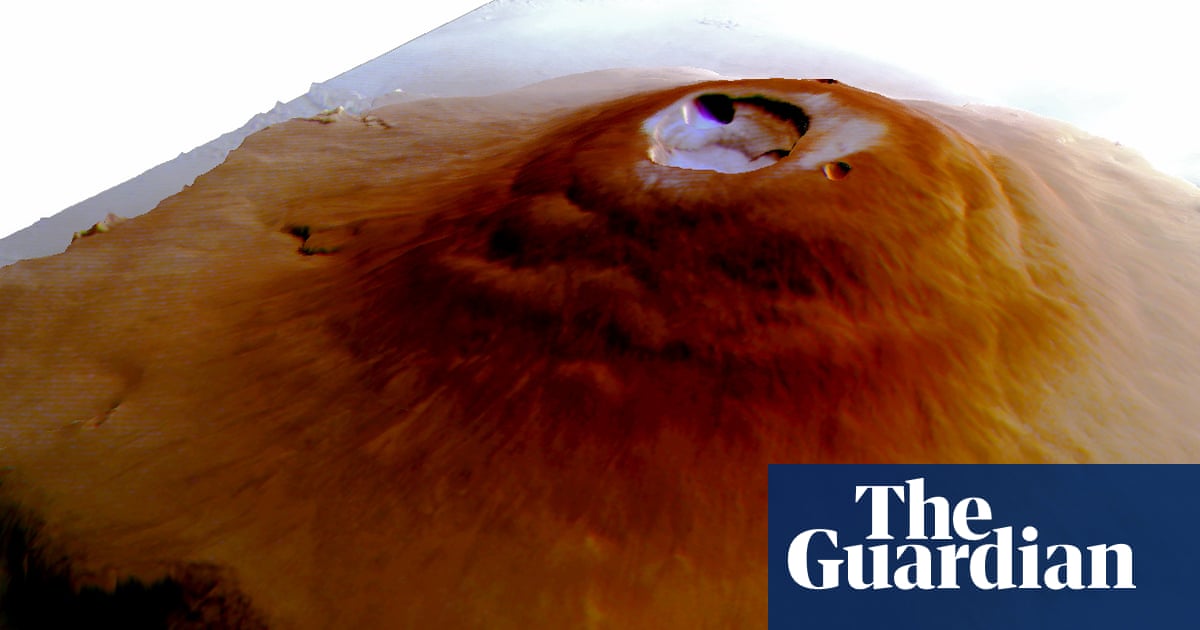Early morning frost has been spotted on some of the largest mountains in the solar system – the colossal Martian volcanoes that rise up to three times the height of Mount Everest near the planet’s equator.
In colder months the fine dusting of ice, thinner than a human hair, appears to form overnight in the volcanoes’ summit craters, or calderas, and on sections of their rims and then to evaporate a few hours after sunrise.
While the frosty layer is exceptionally thin, it covers an enormous area. Scientists calculate that in the more frigid Martian seasons, 150,000 tonnes of water, equivalent to 60 Olympic swimming pools, condense daily on the tops of the towering mountains.
“It’s the first time we’ve discovered water frost on the volcano summits and the first time we’ve discovered water frost in the equatorial regions of Mars,” said Adomas Valantinas, a planetary scientist at the University of Berne in Switzerland and Brown University in the US.
Spacecraft in orbit around Mars have previously beamed back evidence for frozen and liquid water on the red planet, with substantial amounts of ice seen at the north and south poles. Patterns on the landscape suggest the planet was once a far wetter, and perhaps even habitable, world strewn with giant lakes and meandering rivers.
“What we’re seeing could be a trace of a past Martian climate,” Valantinas said of the frost-tipped volcanoes. “It could be related to atmospheric climate processes that were operating earlier in Martian history, maybe millions of years ago.”
Valantinas spotted the frost-capped volcanoes in high-resolution colour images snapped in the early morning hours on Mars by the European Space Agency’s Trace Gas Orbiter (TGO).
With colleagues, he confirmed the discovery using a spectrometer on TGO and further images taken by the agency’s Mars Express orbiter. The frost appears as a bluish hue on the caldera floors and is absent from well-lit slopes.
The Tharsis region of Mars is a vast volcanic plateau near the planet’s equator. It is home to a dozen large volcanoes, including Pavonis Mons and Olympus Mons, which at nearly nine and 16 miles tall respectively are nearly two and three times as tall as Everest. Olympus Mons is far wider than it is tall, covering an area the size of France.
Scientists thought it was unlikely that frost could form on the Tharsis volcano tops because sunshine and the thin Martian atmosphere keep daytime temperatures relatively high, both at the peaks and at ground level.
But, writing in Nature Geoscience, the researchers describe how Martian winds may blow up the mountainsides and carry more moist air into the calderas where it condenses and settles as frost at particular times of year. Modelling of the process suggests the frost is water ice as the peaks are not cold enough for carbon dioxide frost to form.
John Bridges, professor of planetary sciences at the University of Leicester, said the work showed the ongoing success of the TGO mission and its Colour and Stereo Surface Imaging System (CaSSIS) camera.
“Understanding the present day water cycle on Mars in the atmosphere and near surface will be important for future exploration missions including human ones where water will be the key in situ resource,” he added.







